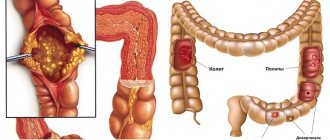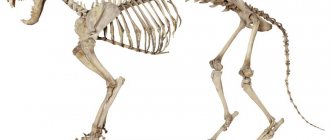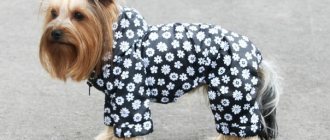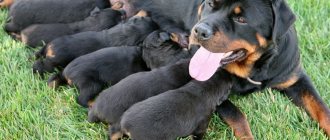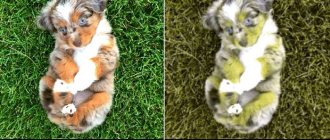Spondylosis in dogs is a common disease that causes the animal a lot of discomfort. And if earlier it affected the body of large animals, now small breeds also suffer from this disease. In addition to treating this disease, special attention and care is required from the pet owner. Additionally, simple training, proper nutrition, and various treatment methods that eliminate pain are recommended.
Like people, animals become more susceptible to various diseases and illnesses as they age. Problems with the spine in this case are the most common and require immediate consultation with a specialist. Aging and local damage to individual segments of the spine can result from age-related changes. Disruption of the spine affects nerve cells and the functioning of the body as a whole.
Content
1. What is the essence of spondylosis in a dog? 2. Causes of occurrence 3. Signs of the disease 4. Treatment methods 5. Forecasts for the future with spondylosis in dogs
It is generally accepted that spondylosis in dogs is an age-related disease that develops after the active period of life. And indeed, there is a certain amount of truth in this. But it is important to understand that this disease can also be found in young dogs, even puppies, but the reasons that act as a catalyst may be different.
Basic information about the disease
Spondylosis often develops in older dogs, and this disease causes bone spurs to form on the vertebrae.
With spondylosis, local aging of some parts of the spine occurs with the formation of bone spurs along the edge. This can happen with one vertebra or with several at once.
Most often, these spurs - osteophytes - can be found in the thoracic or lumbar spine. Often they grow so much that they look more like new bones.
The grown spines irritate the spinal ligament, put pressure on the nerve endings, and narrow the spinal canal. This disease develops extremely slowly, at the very beginning affecting the outer fibers of the fibrous ring.
Interesting! Spurs on the bones of the spine are formed due to instability of the vertebrae. Experts suggest that the size of osteophytes is due to the need to strengthen the broken bone connection.
As the disease progresses, the dog's lumbar spine loses mobility and the chest becomes deformed. Spondylosis is most likely to occur in animals over 6 years of age that do not show signs of lumbago or sciatica.
Although this disease is typical for older dogs, its development can be triggered by:
Spondylosis most often occurs in German Boxer dogs.
- long-term stress accompanied by poor posture;
- osteochondrosis;
- impaired metabolism;
- spinal column injuries;
- hypothermia.
It is important to know that in some cases the disease is caused by a hereditary predisposition. Veterinarians say that boxers are most susceptible to spondylosis, and 9 out of 10 dogs die from this disease.
What is the essence of spondylosis in a dog?
From a physiological point of view, disease is the following process. In some parts of the animal's spine, so-called spurs are formed on one or more vertebrae - bone processes that narrow the brain canal and actively irritate the nerve endings. All this ultimately creates considerable discomfort, makes movement difficult, and causes pain.
In the vast majority of cases, with the exception of those discussed below, this disease develops very slowly; the shoots grow for more than one year. That is why spondylosis in dogs is considered to be a “disease of old age.” And the older the dog gets, the larger and more massive the spurs become. Ultimately, it is not possible to distinguish them from bones, at least not to a specialist.
Mechanism of occurrence
Normally, ligaments are attached to the vertebrae, giving the necessary flexibility to the spine and protecting the spinal cord. Intervertebral discs act as shock absorbers and soften movements.
Growths (osteophytes) are formed due to age-related disorders of the ligamentous apparatus and as a kind of protective reaction to the destruction of intervertebral discs. Presumably, they grow to large sizes to strengthen damaged joints.
Growths can occur in one place (on one vertebra) or in several places along the spine. Most often they are found in the thoracic and lumbar regions. Pathology has a significant impact on vertebral density. They become more susceptible to disease and traumatic injury. In addition, osteophytes can press the vertebrae together, thereby squeezing the nerve endings. Sometimes the growths grow to such an extent that they resemble new bones that have suddenly grown.
Causes
As already noted, most often we are talking about inevitable age-related changes, when the bones of the spine can no longer properly cope with their responsibilities. Nature begins to supplement the dog’s “frame” with new elements to increase rigidity. However, sometimes there are other causes that cause spondylosis in dogs, often at a very young age.
| Physical exercise | Which are associated with changes in posture. We can talk about, say, sled dogs that pull heavy loads in their straps. In this case, even at a relatively young age, problems with the spine are often observed. |
| Osteochondrosis | And other diseases that provoke physical and qualitative changes in the skeleton. If bone tissue is destroyed, then the body in this place tries to form an additional “framework” in the format of these most unwanted spines. |
| Metabolic disease | Including as a result of improper nutrition. If the food is not balanced, if it does not contain enough vital vitamins, minerals and amino acids, then physiological changes in the spine are also observed. |
| Hypothermia | Sometimes the development of spondylosis in dogs is caused by simple hypothermia. At the same time, it is not at all necessary that it be regular - one case is enough for a “bad deed”. A dog can swim in icy water, even by accident. Everything seemed to go well, there were no complications or illnesses. And after some time, the owner finds out that his dog has spondylosis. And not everyone will connect these two events. |
All these factors can stimulate the rapid and very serious in terms of consequences development of the disease, including in young dogs, sometimes even puppies.
Treatment
Spondylosis, like any age-related disease, is incurable. However, with proper care and timely diagnosis, you can provide your pet with a decent quality of life.
For symptomatic treatment, lidase preparations, which have a resolving effect on osteophytes, and painkillers are used. Non-drug pain relief – laser therapy – also provides good results. It is recommended to reduce the weight of the animal as much as possible and give carefully calculated loads. In severe stages of pathology, only surgical treatment to remove osteophytes is possible, but such operations do not provide guarantees.
Prevention of spondylosis consists of balanced feeding and rational stress on the pet. This is especially true for working and sporting dogs - their spine is very susceptible to wear and tear, however, by developing a high-quality training program - from a sports medicine doctor, and using a varied load - including in an aquatic environment (swimming pool, water treadmill), development can be prevented or slowed down. spondylosis.
Spondylosis is also sometimes called ankylosing spondylitis (also known as spondyloarthritis, or ankylosing spondylosis, the full name is Strumpell-Bechterew-Marie disease). However, this pathology of a different genesis has a pronounced breed predisposition - boxers and related breeds suffer from it, and can be diagnosed already at the age of 1.5 - 2 years. However, the clinical manifestations, diagnosis and treatment methods are indeed similar.
Signs of illness
Since this disease does not develop at lightning speed, like, say, inflammatory processes, owners simply get used to slow changes in the pet’s behavior, character, and habits. Often all this is attributed to age. But if desired, an owner who loves and cares about his pet can see signs of spondylosis without special training.
- The mobility of both the dog itself in general and the lumbar region in particular is significantly reduced. The animal becomes clumsy and slow. At some point in time, you begin to notice that your beloved pet, who has always been a “live” and fidgety, no longer rushes through with sharp turns and turns around its axis, but sedately goes about its business. At the same time, when turning, the body no longer bends in the lumbar region.
- If the disease reaches the middle stages, then the dog no longer jumps, even climbing stairs with great difficulty, as well as on other surfaces with a slope.
- If a dog has spondylosis, it is even difficult for him to simply stand up or lie down. A very important symptom, since every owner clearly knows the character of their pet. And if he is reluctant to even get up to a bowl of food, if he is not eager to go outside as before, then it is worth thinking about and remembering the existence of spondylosis in dogs.
- Pain and discomfort when touching the back. The animal no longer “runs” to be petted or to have its back scratched. It should be noted that this symptom does not always appear and can signal the animal owner about completely different problems.
- There is an assumption that dogs literally become weather dependent when pain intensifies when the weather changes. It would seem that animals are naturally like this. There are so many stories about their pets warning people before approaching floods, storms, and fires. However, dogs with the disease in question change their behavior and experience some pain literally before the usual rain.
- In extreme stages, paralysis follows, both complete and partial. But with careful care, it usually doesn’t come to that.
Symptoms
The first signs begin with the owner beginning to notice how his pet’s spinal mobility begins to decrease, this is especially noticeable in the lumbar region. Outwardly, this is expressed in the fact that the dog becomes somewhat hunched over.
In the moderate form of spondylosis, the animal has difficulty overcoming obstacles. A long walk becomes a real torture, at the end of which the dog whines. Painful squeals in a pet are caused by jumping, climbing stairs, as well as standing up and laying down on the floor. If you put pressure on your pet's spine, the reaction will be pain.
As ossification grows, symptoms such as complete or partial paralysis of the entire body are possible, and coordination of movements is impaired. Even slow walking causes discomfort; the dog prefers to lie in one place. In an older pet, spondylosis manifests itself as a hardening of the chest.
Treatment methods
There is an opinion among scientists that spondylosis in dogs is an inevitability that all dogs come to sooner or later. For this reason, treatment, as a rule, is not prescribed until the animal begins to experience pain. In the most extreme cases, if the owner wishes, lidase injections can be prescribed in the early stages to dissolve the developing spines. But this is expensive and often ineffective.
If pain is still present, then the following basic treatment options are possible:
- Painkillers are prescribed, which the pet will have to be given constantly;
- In cases of severe growths that damage the spinal cord and block the canal, surgical intervention is recommended;
- Diet, physiotherapeutic measures and the most complete rest will significantly improve the animal’s well-being.
Methods for diagnosing the disease
To make a diagnosis, a specialist requires an x-ray of the spine. Sometimes the disease is detected during a random X-ray examination aimed at other organs.
The main way to diagnose spondylosis is an x-ray of the spine.
Nowadays, it is not possible to distinguish bone formations that have arisen as a result of age-related changes from osteophytes that have appeared for other reasons. However, there may not be any differences. Multiple x-rays are required to fully assess the condition of the bones and detect damage. It is especially important to monitor this if there are neurological disorders or if the animal is in severe pain.
In addition to x-rays, the doctor may prescribe an MRI or myelogram. Sometimes a consultation with an orthopedic veterinarian is required.
Curious! Some experts believe that spondylosis affects every animal that lives long enough to experience it.
Video about spinal injuries in dogs
We continue to treat our four-legged friends, and today we will talk about problems associated with diseases of the musculoskeletal system. As you know, hunting dogs have more physical exertion than domestic pets, who prefer to lie down somewhere in a warm, dry place in bad weather rather than chase game. And therefore, owners need to especially carefully monitor the health of their helpers.
Unfortunately, our smaller brothers suffer from the same ailments as people. Dogs are also affected by health problems such as spondylosis and osteochondrosis. It was previously thought that the latter of these two diseases did not occur in animals because they were not “upright walkers.”
But now veterinarians are increasingly discovering osteochondrosis in our four-legged pets. However, when making a diagnosis, other medical terms are usually used: dorsopathy, osteochondritis dissecans, ankylosing spondylosis and discopathy.
Osteochondrosis
With this disease, the mineralization of cartilage is disrupted, intervertebral discs are affected, and subsequently the vertebrae themselves. According to experts, the risk of osteochondrosis increases with genetic predisposition and congenital developmental anomalies as a result of intraspecific crossing. External causes also have a serious impact: the state of the environment, the quality of water and food, excess weight, excess calcium in the diet, as well as injuries.
The disease can affect both articular cartilage and intervertebral discs. In the first case, the symptoms of osteochondrosis will be progressive lameness and an unsteady gait, as the dog’s limbs begin to tangle. In a sitting position, she can fall to the side and put out her back paw for support.
Develops more slowly. In this case, there is discomfort when moving, a decrease in the sensitivity of the limbs, up to its complete loss in advanced cases.
Each animal experiences the disease differently. For many, it is not noticeable at first. But sometimes, as early as five months, a puppy begins to shift its center of gravity to its chest when walking. As a result, the front legs are constantly with the elbows apart, the muscles of the hind limbs atrophy, all this can be accompanied by curvature of the spine.
There is a point of view that in advanced cases, osteochondrosis threatens complete failure of the hind legs. Of course, the disease should not be allowed to reach such a state. If you suddenly notice the above symptoms in your pet, you should immediately contact a specialist.
The veterinarian will first of all conduct a thorough examination of the animal. Upon palpation, you can detect crackling and crunching in the affected joint. An additional examination is possible - a referral for x-rays, magnetic resonance imaging or myelography.
Treatment largely depends on the stage of the disease. At an early stage, diet therapy with special food is important. If damage to the articular cartilage is detected, then physiotherapy, ozokerite therapy, laser therapy are prescribed and drugs are used that improve blood circulation in the joint.
If osteochondrosis of the intervertebral discs
, then anti-inflammatory, painkillers (non-steroidal) and decongestants are used for treatment. Drugs that improve microcirculation in tissues, chondroprotectors, and glucocorticoids are needed.
In parallel, physiotherapy (magnetic therapy) is carried out - a UMI device on the affected area and nearby areas of the spine, as well as massage, controlled swimming, in some cases even acupuncture. Nowadays osteopathy (a type of manual therapy) is increasingly being practiced, which shows good results in the treatment of osteochondrosis in dogs.
In advanced cases, surgery is performed with a reduction in caloric intake and dosed exercise during the rehabilitation period.
Spondylopathy (deforming spondylosis)
With spondylosis in dogs, degenerative changes occur in segments of the spine and osteophytes—bone growths—appear. Most often, this disease affects large pets that are more than six years old.
The disease progresses slowly. Over time, the animal's mobility of the lumbar spine decreases, the shape of the chest changes, and a hunched back appears. The development of the disease can be facilitated by hereditary predisposition, osteochondrosis, trauma, metabolic disorders, hypothermia and excessive repetitive stress that falls on the same joints or bones when performing certain exercises.
At an early stage, spondylosis usually occurs without noticeable symptoms. However, already at this stage, growing osteophytes can be detected by palpation. As the disease progresses, the animal's activity will decrease and its gait will become tense.
With moderate spondylopathy, the dog will not be able to jump or walk up stairs. It will be difficult for your pet to lie down and get up. Movement, especially after a long period of rest in a static position, can cause sharp pain. A severe form of the disease threatens loss of coordination and even paresis (partial paralysis) of the hind limbs.
To identify spondylosis in a dog, a thorough diagnosis is required - blood and urine tests, as well as an x-ray examination to detect osteophytes. The veterinarian may also prescribe a myelography, computed tomography or magnetic resonance imaging.
Treatment will depend on the stage at which the disease was discovered. As a rule, the dog is given painkillers and absorbents, the dose of which will depend on its weight, age and breed characteristics; sometimes chondroprotectors, acupuncture, acupressure, laser and magnetic therapy are recommended. Nowadays, homeopathic medicines are widely used, which bring good results. During treatment, it is recommended to avoid excessive physical activity and reduce the pet’s weight.
In advanced cases of spondylosis, surgery will be required to remove osteophytes and connect intervertebral discs (if necessary). This is a very complex procedure, after which a long period of rehabilitation will be required. The pet will return to normal life only after a few weeks.
In conclusion, I would like to note once again that diseases of the musculoskeletal system develop slowly, at first without pronounced symptoms, so always pay attention to the unusual behavior of your pet.
Visit your veterinarian regularly as it is much easier to treat or slow the growth of the disease at an early stage. Be attentive, love your pets, take care of their health, and they will answer you in kind, delighting you with hunting trophies for a long time!
Elena Prokopyeva
, veterinarian
Spinal disease in dogs, which is characterized by severe pain and neurological disorders, most often has an infectious origin - it is nothing more than discospondylitis.
Discospondylitis is a disease that affects the intervertebral disc, and in particular its internal contents - the nucleus, which subsequently leads to neurological symptoms. In addition to the nucleus pulposus, this process involves the vertebral endplates and vertebral bodies, which leads to dysfunction of the spine, various deformities and neurological disorders.
Discospondylitis is a very common disease in veterinary practice, but it is quite difficult to diagnose at the initial stage of disease development. This is not a genetic pathology, and it occurs in all types of dogs and even cats. There are a number of dogs that suffer from a breed predisposition to immunosuppression. These are breeds such as Rottweiler, Bernese Mountain Dog, Basset Hound, Great Dane, and Boxer. These breeds are most likely to develop discospondylitis.
This disease occurs more often in males than in females.
Discospondylitis and its symptoms in dogs
In the veterinary practice of specialists at the RosVet Center, the disease occurs frequently, but only in 5-7% of cases is it diagnosed at the initial stage of development. The reason for this is the late treatment of the owners; they almost always hope that it will “go away on its own” or self-medicate without finding out the cause of the symptoms.
The pathology is not genetically inherited and occurs equally in all dog breeds. The Basset Hound, Rottweiler, Boxer, and Great Dane are predisposed to immunosuppression; discospondylitis is more common in them, although this does not confirm that all representatives of these breeds will be diagnosed with the disease.
CT images, collection of material for biological examination
Discospondylitis occurs in:
- acute;
- chronic forms.
It is more common in males, develops differently, but is diagnosed mainly in animals under 5 years of age.
In both acute and chronic forms, the disease is accompanied by pain, local or radiating (spreading) in different directions, depending on the location of the infringement and compression of the nerve structures. The stronger the pinching, the more painful the pain syndrome manifests itself.
When the spinal cord and nerve fibers are compressed, motor function is lost; the dog does not raise the pelvis, does not move its hind legs, and often walks under itself. Although in clinical practice, tetraplegia and paraplegia (one-sided or complete paralysis when the cervical vertebrae are affected) are rarely encountered with discospondylitis. Outpatient proprioceptive paresis and proprioceptive ataxia are more often observed.
Treatment of diseases
Veterinary medicine has both conservative and surgical methods for treating diseased spine in four-legged friends. The goal of conservative therapy is primarily effective pain relief and reduction of the inflammatory reaction in the pathological focus.
At the initial stages of degenerative processes, the use of corticosteroid drugs is effective: Prednisolone, Dexamethasone, Metipred. The dosage and duration of the course are determined by a veterinarian in each specific case.
To relieve pain, anesthetics are used: Meloxicam, Rimadyl, Tramadol. Prescribing a conduction novocaine blockade is also effective.
Many experts note the positive effect of the use of non-steroidal anti-inflammatory drugs, as well as muscle relaxants, for example, Diazepam.
In addition to drug therapy, surgical treatment methods are also used in veterinary practice. So, using a scalpel, the animal is rid of osteophytes. A highly qualified doctor performs surgery on the spinal column to remove the hernial lesion. In some cases, implants are used to replace damaged vertebrae.
Prevention of spinal diseases
It is not possible to completely protect your pet from various spinal injuries and genetic diseases. But there are a number of recommendations, following which, the owner will be able to reduce the risks of developing pathologies.
It is important to maintain the dog’s body at a normal physiological weight, avoiding overfeeding and obesity. To prevent injury and damage, the nature of physical activity should not be extremely aggressive.
Special stands for bowls can prevent discopathy in the cervical spine, preventing sagging of the ridge. The diet of dogs should be enriched with the necessary vitamin and mineral complexes, reducing the risk of developing dystrophic type processes in cartilaginous tissue structures.
Diagnostics
If a dog is suspected of having pathologies in the spinal column, a professional will prescribe a series of tests to identify the main cause of the disease. Special neurological tests are used to make a diagnosis.
An x-ray of the dog's spine is also necessary, which will allow visualization of the degenerative processes occurring.
X-ray makes it possible to see the location of osteophytes, to suspect narrowing of the spinal cord canal, the presence of mineral structures and hernias.
Contrast radiography - myelogram, is carried out for the purpose of detailed examination and differentiation. This technique allows you to identify the location of the hernia more accurately and assess the condition of spinal cord damage. Modern veterinary hospitals use magnetic resonance imaging.
Prevention by prevention
Since it is common for any body to age, it is worth paying a lot of attention to keep the dog healthy. Spondylosis can occur for many reasons; the main thing is to seek help in time and not self-medicate. Also, doctors do not recommend using traditional methods of treatment for this disease, as they can increase sensitivity and develop allergic reactions.
In addition, the dog should always have fresh food and constant access to water. You can select various supplements and vitamins to strengthen bones, boost the immune system, and monitor uniform loads. Good care and timely seeking medical help will help prolong the life of your pet.
It is necessary to constantly monitor the animal’s behavior and contact with other animals that may be carriers of infectious diseases. If your pet suffers from spondylosis, you should limit contact with other dogs, as any infections can aggravate the condition of your four-legged friend.
Therapy and treatment
There are no universal recommendations for curing spondylosis.
- Therapy should be directed to a specific, individual animal. An individual approach is determined by the nature of the degenerative change, the extent, and the stages of the pathological process. But you also need to take into account all accompanying or provoking factors.
- If the pet has no pain, this manifestation does not require special treatment. It is enough to ensure a normal existence, balance the diet and avoid stress. Limit dangerous situations during which injuries are possible, surround the animal with attention and care.
- If pain is present, it is recommended to prescribe anesthetics and corticosteroids to relieve the inflammatory process. But it is also advisable to stick to a light diet. Food should be easily digestible, foods containing little fat and a lot of fiber. Physiotherapy is carried out on the affected area.
- Surgery is less commonly used. This measure is necessary in cases where the spinal cord roots are pinched by osteophytes. If surgery is not performed, the pinching worsens and paralysis occurs. That is why it is extremely important to conduct a multi-stage radiographic examination.
- The main treatment should be aimed at eliminating symptoms and associated diseases. If this is an infectious pathology or inflammation is present, antibiotics and anti-inflammatory drugs are recommended for use. Severe pain is eliminated with antispasmodics, analgesics, and painkillers.
For pain, anesthetics are prescribed.
What is discospondylitis?
Discospondylitis is a bacterial or fungal infection of the vertebrae or intervertebral discs in dogs. As a result, swelling, inflammation and deformation of the vertebra compresses the spinal cord that runs through that vertebra. If only one vertebra is affected, the disease is called spondylitis. The disease should not be confused with spondylosis, which is a non-infectious degeneration of the vertebra.
Etiology and pathogenesis
The cause of discospondylitis in dogs may be a breed predisposition (German and Bernese shepherds), an infectious process (brucellosis, aspergillosis), a foreign body (grass seeds, needles and thorns of plants, wood chips), postoperative infection (not sterile suture material), as well as immunosuppressive state of the body.
The anatomical feature of the vascular network of the vertebral bodies is such that the vascular bundle in the area of the intervertebral space makes a kind of bend (loop), which is a favorable factor for the settling of infectious agents there.
This choroid plexus is localized in dogs at the level of the lumbar spine, which explains the most typical localization of the process.
Prognosis for the disease
If the dog owner’s application occurred in the first stages of the appearance of clinical signs of discospondylitis, the prognosis is favorable. This way, it is possible to quickly remove the cause of disc deformation and prevent irreversible processes from developing in the bone structures. In advanced cases, the prognosis ranges from cautious to unfavorable - long-term compression of spinal structures, paresis, and paralysis cannot be ruled out.
If your dog has a predisposition to discospondylitis, you notice that characteristic neurological signs have appeared or your pet is behaving unusually - don’t hesitate! Call the RosVet VC and make an appointment for an examination with a neurologist (surgeon) by phone, 24 hours a day.
